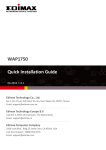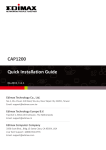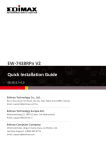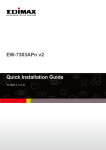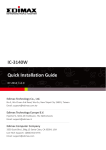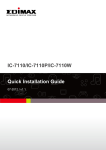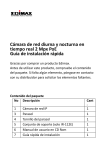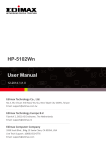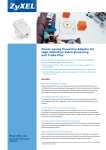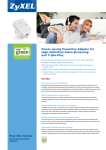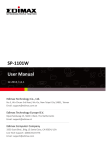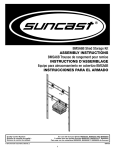Download GS-5424PLG User Manual
Transcript
GS-5424PLG User Manual 06-2015 / v1.0 Table of Contents Chapter 1 Product Introduction.................................................................................................................................3 1.1 Product Overview .........................................................................................................................................3 1.2 Features ........................................................................................................................................................3 1.3 External Component Description ..................................................................................................................3 1.3.1 Front Panel .........................................................................................................................................3 1.3.2 Rear Panel ..........................................................................................................................................5 1.4 Package Contents ..........................................................................................................................................5 Chapter 2 Installing and Connecting the Switch .......................................................................................................6 2.1 Installation ....................................................................................................................................................6 2.1.1 Desktop Installation ...........................................................................................................................6 2.1.2 Rack-mountable Installation in 19-inch Cabinet ................................................................................6 2.1.3 Power on the Switch ..........................................................................................................................7 2.2 Connect Computer (NIC) to the Switch.........................................................................................................8 2.3 Switch connection to the PD.........................................................................................................................8 Chapter 3 How to Login the Switch ...........................................................................................................................9 3.1 Switch to End Node.......................................................................................................................................9 3.2 How to Login the Switch ...............................................................................................................................9 Chapter 4 Switch Configuration...............................................................................................................................11 4.1 System Status ..............................................................................................................................................12 4.1.1 Device Information ..........................................................................................................................12 4.1.2 Port Flow Chart ................................................................................................................................12 4.1.3 Traffic Statistics ................................................................................................................................15 4.2 Network ......................................................................................................................................................17 4.2.1 IP Address ........................................................................................................................................17 4.2.2 MAC Addresses ................................................................................................................................17 4.2.3 DNS Settings.....................................................................................................................................18 4.2.4 DHCP Protect ...................................................................................................................................18 4.2.5 IGMP Snooping ................................................................................................................................18 4.3 Port Configuration ......................................................................................................................................19 4.3.1 Port Configuration............................................................................................................................19 4.3.2 Port Mirroring ..................................................................................................................................20 4.3.3 MAC Limit.........................................................................................................................................20 4.3.4 Port Aggregation ..............................................................................................................................21 4.3.4. ACL ..................................................................................................................................................22 4.3.5 Port Limit..........................................................................................................................................23 4.3.6 Storm Control...................................................................................................................................24 4.4 Port Security ...............................................................................................................................................25 4.4.1 Port Grouping...................................................................................................................................25 4.5 VALAN Configuration ..................................................................................................................................25 4.5.1 802.1Q VLAN ....................................................................................................................................25 4.5.2 PVID ..............................................................................................................................................26 4.6.POE Configuration.......................................................................................................................................27 4.6.1. POE Global Setting ..........................................................................................................................27 4.6.2 Power Priority ..................................................................................................................................28 4.6.3 Power Supply ...................................................................................................................................29 4.6.4.Power Limitation..............................................................................................................................30 4.6.5 POE Status ........................................................................................................................................31 4.7 System Settings ...........................................................................................................................................32 4.7.1 Quick Settings ..................................................................................................................................32 4.7.2 WEB Management ...........................................................................................................................32 4.7.3 Administrator ...................................................................................................................................32 4.7.4 System Config...................................................................................................................................33 4.7.5 Firmware Upgrade ...........................................................................................................................34 4.7.6 System Time.....................................................................................................................................34 4.7.7 Reboot..............................................................................................................................................34 4.8 System log ...................................................................................................................................................35 4.8.1.Event Log..........................................................................................................................................35 4.8.2 Alarm Log .........................................................................................................................................35 4.8.3 Security Log......................................................................................................................................36 4.8.4 Network Log .....................................................................................................................................36 4.8.5 Protocol Log .....................................................................................................................................36 Chapter 1 Product Introduction Thank you for purchasing an Edimax PoE Web Smart Ethernet Switch. Before you install and use the product, please read this manual carefully to make the best use of the product’s functions. 1.1 Product Overview The Edimax Pro GS-5424PLG is a web-smart switch with 24 Gigabit PoE+ ports and four Gigabit SFP slots. Designed for medium to large network environments, its standard 19-inch rack-mount brackets allow for integration with the most widely used mounting systems on the market. The Edimax GS-5424PLG is a superb choice to boost your network environment’s performance and efficiency. 1.2 Features Supports 24 10/100/1000Mbps Gigabit Ethernet ports and 4 mini-GBIC/SFP slots IEEE 802.3af/at PoE compliant to simplify deployment and installation Supports PoE up to 30 W per port with 400 W total power budget Automatically detects powered devices (PD) and power consumption levels IEEE 802.1Q VLAN allows network segmentation to enhance performance and security Supports Access Control List (ACL) Switch capacity: 56Gbps, Forwarding rate: 35.7Mbps Supports IGMP Snooping V1 / V2 8K MAC address table and 9K jumbo frames 19-inch rack-mountable metal case 1.3 External Component Description 1.3.1 Front Panel The front panel of the switch consists of 24 x 10/100/1000Mbps RJ-45 ports, 4 x SFP ports and a series of LED indicators as shown as below: Front Panel 10/100/1000Mbps RJ-45 ports (1~24): Designed to connect to network devices with a bandwidth of 10Mbps, 100Mbps or 1000Mbps. Each has a corresponding 10/100/1000Mbps LED. SFP ports (SFP1, SFP2, SFP3, SFP4): Designed to install SFP modules and connect to network devices with a bandwidth of 1000Mbps. Each has a corresponding 1000Mbps LED. LED indicators: The LED Indicators will allow you to monitor, diagnose and troubleshoot any potential problem with the switch, connection or attached devices. LED Indicators The following chart shows the LED indicators of the Switch along with explanation of each indicator. Power: Green Off: Power off On: Power on System: Green Off: System not ready On: System ready Blinking: System booting Copper Port 1G: Green Off: No 1G link On: 1G link Copper Port: Yellow Off: 100M link fail Flashing: Sending or receiving data SFP: Green Off: Link fail On: Connected SFP: Yellow LED Off: Not sending or receiving data Flashing: Sending or receiving data 1.3.2 Rear Panel The rear panel of the switch features the AC power connector: Rear Panel AC Power Connector: Power is supplied through an external AC power adapter. Supports AC 100 – 240V, 50-60Hz 1.4 Package Contents Before you start using this product, please check if there is anything missing in the package, and contact your dealer to claim the missing item(s): GS-5424PLG POE Web Smart Switch Quick Installation Guide CD Power Cord Rack-Mount Kit Chapter 2 Installing and Connecting the Switch This chapter describes how to install and connect your PoE Ethernet Switch. Please read the following topics and perform the procedures in the correct order. Incorrect installation may cause damage to the product. 2.1 Installation Put the switch in a stable place such as a desktop to avoid falling. Ensure the switch works in the proper AC input range and matches the voltage labeled. Do not open the switch’s outer case even in the event of power failure. Ensure there is proper heat dissipation from and adequate ventilation around the switch. Ensure the switch’s location can support the weight of the switch and its accessories. 2.1.1 Desktop Installation Where standard 19-inch cabinet is not available, install the switch on a desktop and attach the cushioning rubber feet provided on the bottom corners of the switch to protect against external vibration. Allow adequate space for ventilation between the device and any objects around. i Figure 4 - Desktop Installation 2.1.2 Rack-mountable Installation in 19-inch Cabinet The switch can be mounted in an EIA standard-sized 19-inch rack which can be placed in a wiring closet with other equipment. To install the switch, please follow these steps: A. Attach the mounting brackets on the switch’s side panels (one on each side) and secure them with the screws provided. Bracket Installation B. Use the screws provided with the equipment rack to mount the Switch on the rack and tighten it. Rack Installation 2.1.3 Power on the Switch The Switch is powered on by the AC 100-240 V 50/60Hz internal high-performance power supply. AC Electrical Outlet: It is recommended to use a single-phase three-wire receptacle with neutral outlet or multifunctional computer professional receptacle. Please make sure to connect the metal ground connector to the grounding source on the outlet. AC Power Cord Connection: Connect the AC power connector on the back panel of the switch to external receptacle with the included power cord, and check the power LED is on. 2.2 Connect Computer (NIC) to the Switch Please insert the NIC into the computer, and after installing network card driver connect one end of the RJ-45 cable to your computer and the other end to any RJ-45 port of the switch, with a maximum distance between switch and computer around 100 meters. After the devices are powered on the LINK/ACT/Speed status indicator lights will display for corresponding ports of the switch. 2.3 Switch connection to the PD (Powered Device) Ports 1-24 provide PoE power supply functionality with a maximum output power up to 30W each port. This can power PD devices such as internet phones, network cameras, wireless access points etc. Connect the switch PoE port directly connected to the PD port using a network cable. Chapter 3 Login 3.1 Switch to End Node Use a standard Cat 5/5e Ethernet cable (UTP/STP) to connect the switch to end nodes as shown below. Switch ports will automatically adjust to the characteristics (MDI/MDI-X, speed, duplex) of the device to which it’s connected. PC Connect 3.2 Login Open a web browser and go to the switch’s IP address. The default IP address is 192.168.2.1. Your computer’s IP address must be in the same subnet as the switch. For the default IP address this is any IP address in the range 192.168.2.x (x = 2 – 254). You can modify the IP address of your computer if you need. Default IP address 192.168.2.1 Default user name admin Default password 1234 1. Enter the switch’s IP address (192.168.2.1) in the URL bar of a web browser. IE 7 or above is recommended. 2. At the following screen login with the default username “admin” and password “1234”. 3. You will arrive at the switch configuration window as shown below: Chapter 4 Switch Configuration The PoE smart switch software provides rich layer 2 functionality for switches in your networks. This chapter describes how to use the web-based management interface (Web UI) to configure the switch’s features. The left column shows the configuration menu. The top row shows the switch’s current link status. Green squares indicate the port link is up, while black squares indicate the port link is down. Below the switch panel, you can find a common toolbar to provide useful functions. The rest of the screen area displays the configuration settings. 4.1 System Status View device information and status. 4.1.1 Device Information Go to Status > Device Information This page allow you to configure status related information and view status information such as Device ID, MAC address, IP Address and System Time. Host Name: System name of the switch. This name will also be used as CLI prefix. 4.1.2 Port Flow Chart System Status > Port Flow Chart Port Select: Select one or multiple ports to configure. Enabled: Port admin state. Enabled: Enable the port. Disabled: Disable the port. 4.1.3 Traffic Statistics 4.1.4 Mac Table 4.1.4.1 Forwarding List 4.1.4.2 Set Static MAC Mac Table > Set Static MAC MAC Address: The MAC address to which packets will be statically forwarded. If Type is uncast, enter uncast MAC address in this field; If Type is multicast, enter multicast MAC address in this field. Port: If Type is uncast, select the port number of the MAC entry; If Type is multicast, select the port list of the MAC entry. VLAN: The VLAN ID number of the VLAN on which the above MAC address resides. 4.1.4.3 Dynamic Address Settings Mac Table > Dynamic Address Settings 4.1.5 System Load Service: Enable: Select CPU Threshold percent & Memory Threshold percent. Disable: CPU Threshold & Memory Threshold disabled. 4.1.6 Network detection 4.2 Network Use the Network page to configure settings for the switch network interface and connections to a remote server. 4.2.1 IP Address Network > IP Address This page allows you to edit IP address, Net Mask and Gateway. IP Address: If static mode is enabled, enter IP address in this field. Net Mask: If static mode is enabled, enter subnet mask in this field. 4.2.2 MAC Addresses Network > MAC Address MAC Address: Select the MAC address to show or clear dynamic MAC entries. If no port, VLAN and MAC address is selected, the dynamic MAC table will be cleared. 4.2.3 DNS Settings Network > MAC Address 4.2.4 DHCP Protect When the switch uses DHCP Protect, it will snoop protect message and DHCP requests and record the IP address and MAC address from DHCP ACK messages. DHCP Protect allows physical ports to be set as creditable ports or discreditable ports. Creditable ports can receive and forward the DHCP offer message while discreditable port will lose the DHCP offer message. This is sho the switch can identify false DHCP servers and ensure that the client gets a legal IP address from DHCP Server. 4.2.5 IGMP Snooping Network > IGMP Snooping 4.3 Port Configuration 4.3.1 Port Configuration 4.3.2 Port Mirroring Port mirroring is mirroring the TX/RX data flow from the source port to the destination port. 4.3.3 MAC Limit 4.3.4 Port Aggregation Aggregate multiple Ethernet ports together to form a logical port, supports static allocation or LACP. 4.3.4. ACL ACL > Bounding List This page allows you to set port bounding ACL rules. 4.3.5 Port Limit Ingress & Egress Port Settings Rate Limit > Ingress & Egress Port Settings This page allows you to set ingress port monitoring. 4.3.6 Storm Control Port Configuration > Storm Control Port: Select ports. Type Enable: Select the type of storm control. Broadcast: Broadcast packet. Unknown Multicast: Unknown multicast packet State. Unknown Uncast: Unknown uncast packet. Rate: Value of storm control rate. Unit: PPS (packet per-second) or Kbps (Kbits per-second) depends on global mode setting. The range is from 0 to 1000000. 4.4 Port Security 4.4.1 Port Grouping Security> Port Grouping Port security can set port isolation and specific behavior. 4.5 VLAN Configuration 4.5.1 802.1Q VLAN VLAN Configuration > VLAN List 4.5.2 PVID VLAN ID for the selected ports: 4.6.POE Configuration 4.6.1. PoE Global Setting PoE Configuration > PoE Global Setting This page is used to check PoE Status. You can set max available power here. Max Available Power: Switch configuration can provide maximum power. System Operation Status:Display POE operation status on or off. Main Power Consumption: Configure main power consumption. 4.6.2 Power Priority 4.6.3 Power Supply POE Configuration > Power Supply 4.6.4 Power Limitation POE Configuration > Power Limitation 4.6.5 PoE Status This page is used to check POE Status. 4.7 System Settings 4.7.1 Quick Settings 4.7.2 Web Management System Settings > WEB Management 4.7.3 Administrator System Settings > Administrator 4.7.4 System Config 4.7.4.1 Restore Factory Click Restore configuration to restore the switch to its factory default state and reset all settings. 4.7.4.2 Restore Backup 4.7.4.3 Save Current Click Save to download all system configuration files. 4.7.5 Firmware Upgrade System setting> Firmware Upgrade This page allow you to upgrade to new firmware file from a remote TFTP server or from local storage. 4.7.6 System Time System Settings > System Time Set time zone and time services such as automatic daylight savings synchronization. 4.7.7 Reboot System setting > Reboot Reboot the switch by clicking the “Reboot” button. 4.8 System log 4.8.1 Event Log System Log > Event Log 4.8.2 Alarm Log System Log > Alarm Log This page is used to configure alarm groups. 4.8.3 Security Log System Log > Security Log Use the security log page to configure settings for the switch security log. 4.8.4 Network Log System Log > Network Log 4.8.5 Protocol Log System Log > Protocol Log COPYRIGHT Copyright Edimax Technology Co., Ltd. all rights reserved. No part of this publication may be reproduced, transmitted, transcribed, stored in a retrieval system, or translated into any language or computer language, in any form or by any means, electronic, mechanical, magnetic, optical, chemical, manual or otherwise, without the prior written permission from Edimax Technology Co., Ltd. Edimax Technology Co., Ltd. makes no representations or warranties, either expressed or implied, with respect to the contents hereof and specifically disclaims any warranties, merchantability, or fitness for any particular purpose. Any software described in this manual is sold or licensed as is. Should the programs prove defective following their purchase, the buyer (and not this company, its distributor, or its dealer) assumes the entire cost of all necessary servicing, repair, and any incidental or consequential damages resulting from any defect in the software. Edimax Technology Co., Ltd. reserves the right to revise this publication and to make changes from time to time in the contents hereof without the obligation to notify any person of such revision or changes. The product you have purchased and the setup screen may appear slightly different from those shown in this QIG. The software and specifications are subject to change without notice. Please visit our website www.edimax.com for updates. All brand and product names mentioned in this manual are trademarks and/or registered trademarks of their respective holders. Federal Communication Commission Interference Statement This equipment has been tested and found to comply with the limits for a Class B digital device, pursuant to Part 15 of FCC Rules. These limits are designed to provide reasonable protection against harmful interference in a residential installation. This equipment generates, uses, and can radiate radio frequency energy and, if not installed and used in accordance with the instructions, may cause harmful interference to radio communications. However, there is no guarantee that interference will not occur in a particular installation. If this equipment does cause harmful interference to radio or television reception, which can be determined by turning the equipment off and on, the user is encouraged to try to correct the interference by one or more of the following measures: 1. Reorient or relocate the receiving antenna. 2. Increase the separation between the equipment and receiver. 3. Connect the equipment into an outlet on a circuit different from that to which the receiver is connected. 4. Consult the dealer or an experienced radio technician for help. FCC Caution This device and its antenna must not be co-located or operating in conjunction with any other antenna or transmitter. This device complies with Part 15 of the FCC Rules. Operation is subject to the following two conditions: (1) this device may not cause harmful interference, and (2) this device must accept any interference received, including interference that may cause undesired operation. Any changes or modifications not expressly approved by the party responsible for compliance could void the authority to operate equipment. Federal Communications Commission (FCC) Radiation Exposure Statement This equipment complies with FCC radiation exposure set forth for an uncontrolled environment. In order to avoid the possibility of exceeding the FCC radio frequency exposure limits, human proximity to the antenna shall not be less than 2.5cm (1 inch) during normal operation. Federal Communications Commission (FCC) RF Exposure Requirements SAR compliance has been established in the laptop computer(s) configurations with PCMCIA slot on the side near the center, as tested in the application for certification, and can be used in laptop computer(s) with substantially similar physical dimensions, construction, and electrical and RF characteristics. Use in other devices such as PDAs or lap pads is not authorized. This transmitter is restricted for use with the specific antenna tested in the application for certification. The antenna(s) used for this transmitter must not be co-located or operating in conjunction with any other antenna or transmitter. R&TTE Compliance Statement This equipment complies with all the requirements of DIRECTIVE 1999/5/EC OF THE EUROPEAN PARLIAMENT AND THE COUNCIL of March 9, 1999 on radio equipment and telecommunication terminal equipment and the mutual recognition of their conformity (R&TTE). The R&TTE Directive repeals and replaces in the directive 98/13/EEC (Telecommunications Terminal Equipment and Satellite Earth Station Equipment) As of April 8, 2000. Safety This equipment is designed with the utmost care for the safety of those who install and use it. However, special attention must be paid to the dangers of electric shock and static electricity when working with electrical equipment. All guidelines of this and of the computer manufacture must therefore be allowed at all times to ensure the safe use of the equipment. EU Countries Intended for Use The ETSI version of this device is intended for home and office use in Austria, Belgium, Bulgaria, Cyprus, Czech, Denmark, Estonia, Finland, France, Germany, Greece, Hungary, Ireland, Italy, Latvia, Lithuania, Luxembourg, Malta, Netherlands, Poland, Portugal, Romania, Slovakia, Slovenia, Spain, Sweden, Turkey, and United Kingdom. The ETSI version of this device is also authorized for use in EFTA member states: Iceland, Liechtenstein, Norway, and Switzerland. EU Countries Not Intended for Use None EU Declaration of Conformity English: This equipment is in compliance with the essential requirements and other relevant provisions of Directive 1995/5/EC, 2009/125/EC, 2006/95/EC, 2011/65/EC. Français: Cet équipement est conforme aux exigences essentielles et autres dispositions de la directive 1995/5/CE, 2009/125/CE, 2006/95/CE, 2011/65/CE. Čeština: Toto zařízení je v souladu se základními požadavky a ostatními příslušnými ustanoveními směrnic 1995/5/ES, 2009/125/ES, 2006/95/ES, 2011/65/ES. Polski: Urządzenie jest zgodne z ogólnymi wymaganiami oraz szczególnymi warunkami określonymi Dyrektywą UE 1995/5/EC, 2009/125/EC, 2006/95/EC, 2011/65/EC.. Română: Acest echipament este în conformitate cu cerinţele esenţiale şi alte prevederi relevante ale Directivei 1995/5/CE, 2009/125/CE, 2006/95/CE, 2011/65/CE. Русский: Это оборудование соответствует основным требованиям и положениям Директивы 1995/5/EC, 2009/125/EC, 2006/95/EC, 2011/65/EC. Magyar: Ez a berendezés megfelel az alapvető követelményeknek és más vonatkozó irányelveknek (1995/5/EK, 2009/125/EK, 2006/95/EK, 2011/65/EK). Türkçe: Bu cihaz 1995/5/EC, 2009/125/EC, 2006/95/EC, 2011/65/EC direktifleri zorunlu istekler ve diğer hükümlerle ile uyumludur. Українська: Обладнання відповідає вимогам і умовам директиви 1995/5/EC, 2009/125/EC, 2006/95/EC, 2011/65/EC. Slovenčina: Toto zariadenie spĺňa základné požiadavky a ďalšie príslušné ustanovenia smerníc 1995/5/ES, 2009/125/ES, 2006/95/ES, 2011/65/ES. Deutsch: Dieses Gerät erfüllt die Voraussetzungen gemäß den Richtlinien 1995/5/EC, 2009/125/EC, 2006/95/EC, 2011/65/EC. Español: El presente equipo cumple los requisitos esenciales de la Directiva 1995/5/EC, 2009/125/EC, 2006/95/EC, 2011/65/EC. Italiano: Questo apparecchio è conforme ai requisiti essenziali e alle altre disposizioni applicabili della Direttiva 1995/5/CE, 2009/125/CE, 2006/95/CE, 2011/65/CE. Nederlands: Dit apparaat voldoet aan de essentiële eisen en andere van toepassing zijnde bepalingen van richtlijn 1995/5/EC, 2009/125/EC, 2006/95/EC, 2011/65/EC.. Português: Este equipamento cumpre os requesitos essênciais da Directiva 1995/5/EC, 2009/125/EC, 2006/95/EC, 2011/65/EC. Norsk: Dette utstyret er i samsvar med de viktigste kravene og andre relevante regler i Direktiv 1995/5/EC, 2009/125/EC, 2006/95/EC, 2011/65/EC. Svenska: Denna utrustning är i överensstämmelse med de väsentliga kraven och övriga relevanta bestämmelser i direktiv 1995/5/EG, 2009/125/EG, 2006/95/EG, 2011/65/EG. Dansk: Dette udstyr er i overensstemmelse med de væ sentligste krav og andre relevante forordninger i direktiv 1995/5/EC, 2009/125/EC, 2006/95/EC, 2011/65/EC. suomen kieli: Tämä laite täyttää direktiivien 1995/5/EY, 2009/125/EY, 2006/95/EY, 2011/65/EY oleelliset vaatimukset ja muut asiaankuuluvat määräykset. ----------------------------------------------------------------------------------------------------------------WEEE Directive & Product Disposal At the end of its serviceable life, this product should not be treated as household or general waste. It should be handed over to the applicable collection point for the recycling of electrical and electronic equipment, or returned to the supplier for disposal. Declaration of Conformity We, Edimax Technology Co., Ltd., declare under our sole responsibility, that the equipment described below complies with the requirements of the European R&TTE directives. Equipment: GS-5424PLG PoE Web Smart Switch Model No.: GS-5424PLG The following European standards for essential requirements have been followed: EMC : Safety (LVD) : EN55022:2010 EN55024:2010 EN61000-3-2:2006+A1:2009+A2:2009 EN61000-3-3:2013 EN 60950-1:2006 + A11:2009 + A1:2010 + A12:2011+A2:2013 Edimax Technology Co., Ltd. No. 3, Wu Chuan 3rd Road, Wu-Ku Industrial Park, New Taipei City, Taiwan Date of Signature: Jun, 2015 Signature: Printed Name: Albert Chang Title: Director Edimax Technology Co., Ltd. Notice According to GNU General Public License Version 2 This product includes software that is subject to the GNU General Public License version 2. The program is free software and distributed without any warranty of the author. We offer, valid for at least three years, to give you, for a charge no more than the costs of physically performing source distribution, a complete machine-readable copy of the corresponding source code. Das Produkt beinhaltet Software, die den Bedingungen der GNU/GPL-Version 2 unterliegt. Das Programm ist eine sog. „Free Software“, der Autor stellt das Programm ohne irgendeine Gewährleistungen zur Verfügung. Wir bieten Ihnen für einen Zeitraum von drei Jahren an, eine vollständige maschinenlesbare Kopie des Quelltextes der Programme zur Verfügung zu stellen – zu nicht höheren Kosten als denen, die durch den physikalischen Kopiervorgang anfallen. GNU GENERAL PUBLIC LICENSE Version 2, June 1991 Copyright (C) 1989, 1991 Free Software Foundation, Inc. 51 Franklin Street, Fifth Floor, Boston, MA 02110-1301, USA Everyone is permitted to copy and distribute verbatim copies of this license document, but changing it is not allowed. Preamble The licenses for most software are designed to take away your freedom to share and change it. By contrast, the GNU General Public License is intended to guarantee your freedom to share and change free software--to make sure the software is free for all its users. This General Public License applies to most of the Free Software Foundation’s software and to any other program whose authors commit to using it. (Some other Free Software Foundation software is covered by the GNU Lesser General Public License instead.) You can apply it to your programs, too. When we speak of free software, we are referring to freedom, not price. Our General Public Licenses are designed to make sure that you have the freedom to distribute copies of free software (and charge for this service if you wish), that you receive source code or can get it if you want it, that you can change the software or use pieces of it in new free programs; and that you know you can do these things. To protect your rights, we need to make restrictions that forbid anyone to deny you these rights or to ask you to surrender the rights. These restrictions translate to certain responsibilities for you if you distribute copies of the software, or if you modify it. For example, if you distribute copies of such a program, whether gratis or for a fee, you must give the recipients all the rights that you have. You must make sure that they, too, receive or can get the source code. And you must show them these terms so they know their rights. We protect your rights with two steps: (1) copyright the software, and (2) offer you this license which gives you legal permission to copy, distribute and/or modify the software. Also, for each author’s protection and ours, we want to make certain that everyone understands that there is no warranty for this free software. If the software is modified by someone else and passed on, we want its recipients to know that what they have is not the original, so that any problems introduced by others will not reflect on the original authors’ reputations. Finally, any free program is threatened constantly by software patents. We wish to avoid the danger that redistributors of a free program will individually obtain patent licenses, in effect making the program proprietary. To prevent this, we have made it clear that any patent must be licensed for everyone’s free use or not licensed at all. The precise terms and conditions for copying, distribution and modification follow. TERMS AND CONDITIONS FOR COPYING, DISTRIBUTION AND MODIFICATION 0. This License applies to any program or other work which contains a notice placed by the copyright holder saying it may be distributed under the terms of this General Public License. The ‘“Program’“, below, refers to any such program or work, and a ‘“work based on the Program’“ means either the Program or any derivative work under copyright law: that is to say, a work containing the Program or a portion of it, either verbatim or with modifications and/or translated into another language. (Hereinafter, translation is included without limitation in the term ‘“modification’“.) Each licensee is addressed as ‘“you’“. Activities other than copying, distribution and modification are not covered by this License; they are outside its scope. The act of running the Program is not restricted, and the output from the Program is covered only if its contents constitute a work based on the Program (independent of having been made by running the Program). Whether that is true depends on what the Program does. 1. You may copy and distribute verbatim copies of the Program’s source code as you receive it, in any medium, provided that you conspicuously and appropriately publish on each copy an appropriate copyright notice and disclaimer of warranty; keep intact all the notices that refer to this License and to the absence of any warranty; and give any other recipients of the Program a copy of this License along with the Program. You may charge a fee for the physical act of transferring a copy, and you may at your option offer warranty protection in exchange for a fee. 2. You may modify your copy or copies of the Program or any portion of it, thus forming a work based on the Program, and copy and distribute such modifications or work under the terms of Section 1 above, provided that you also meet all of these conditions: a) You must cause the modified files to carry prominent notices stating that you changed the files and the date of any change. b) You must cause any work that you distribute or publish, that in whole or in part contains or is derived from the Program or any part thereof, to be licensed as a whole at no charge to all third parties under the terms of this License. c) If the modified program normally reads commands interactively when run, you must cause it, when started running for such interactive use in the most ordinary way, to print or display an announcement including an appropriate copyright notice and a notice that there is no warranty (or else, saying that you provide a warranty) and that users may redistribute the program under these conditions, and telling the user how to view a copy of this License. (Exception: if the Program itself is interactive but does not normally print such an announcement, your work based on the Program is not required to print an announcement.) These requirements apply to the modified work as a whole. If identifiable sections of that work are not derived from the Program, and can be reasonably considered independent and separate works in themselves, then this License, and its terms, do not apply to those sections when you distribute them as separate works. But when you distribute the same sections as part of a whole which is a work based on the Program, the distribution of the whole must be on the terms of this License, whose permissions for other licensees extend to the entire whole, and thus to each and every part regardless of who wrote it. Thus, it is not the intent of this section to claim rights or contest your rights to work written entirely by you; rather, the intent is to exercise the right to control the distribution of derivative or collective works based on the Program. In addition, mere aggregation of another work not based on the Program with the Program (or with a work based on the Program) on a volume of a storage or distribution medium does not bring the other work under the scope of this License. 3. You may copy and distribute the Program (or a work based on it, under Section 2) in object code or executable form under the terms of Sections 1 and 2 above provided that you also do one of the following: a) Accompany it with the complete corresponding machine-readable source code, which must be distributed under the terms of Sections 1 and 2 above on a medium customarily used for software interchange; or, b) Accompany it with a written offer, valid for at least three years, to give any third party, for a charge no more than your cost of physically performing source distribution, a complete machine-readable copy of the corresponding source code, to be distributed under the terms of Sections 1 and 2 above on a medium customarily used for software interchange; or, c) Accompany it with the information you received as to the offer to distribute corresponding source code. (This alternative is allowed only for noncommercial distribution and only if you received the program in object code or executable form with such an offer, in accord with Subsection b above.) The source code for a work means the preferred form of the work for making modifications to it. For an executable work, complete source code means all the source code for all modules it contains, plus any associated interface definition files, plus the scripts used to control compilation and installation of the executable. However, as a special exception, the source code distributed need not include anything that is normally distributed (in either source or binary form) with the major components (compiler, kernel, and so on) of the operating system on which the executable runs, unless that component itself accompanies the executable. If distribution of executable or object code is made by offering access to copy from a designated place, then offering equivalent access to copy the source code from the same place counts as distribution of the source code, even though third parties are not compelled to copy the source along with the object code. 4. You may not copy, modify, sublicense, or distribute the Program except as expressly provided under this License. Any attempt otherwise to copy, modify, sublicense or distribute the Program is void, and will automatically terminate your rights under this License. However, parties who have received copies, or rights, from you under this License will not have their licenses terminated so long as such parties remain in full compliance. 5. You are not required to accept this License, since you have not signed it. However, nothing else grants you permission to modify or distribute the Program or its derivative works. These actions are prohibited by law if you do not accept this License. Therefore, by modifying or distributing the Program (or any work based on the Program), you indicate your acceptance of this License to do so, and all its terms and conditions for copying, distributing or modifying the Program or works based on it. 6. Each time you redistribute the Program (or any work based on the Program), the recipient automatically receives a license from the original licensor to copy, distribute or modify the Program subject to these terms and conditions. You may not impose any further restrictions on the recipients’ exercise of the rights granted herein. You are not responsible for enforcing compliance by third parties to this License. 7. If, as a consequence of a court judgment or allegation of patent infringement or for any other reason (not limited to patent issues), conditions are imposed on you (whether by court order, agreement or otherwise) that contradict the conditions of this License, they do not excuse you from the conditions of this License. If you cannot distribute so as to satisfy simultaneously your obligations under this License and any other pertinent obligations, then as a consequence you may not distribute the Program at all. For example, if a patent license would not permit royalty-free redistribution of the Program by all those who receive copies directly or indirectly through you, then the only way you could satisfy both it and this License would be to refrain entirely from distribution of the Program. If any portion of this section is held invalid or unenforceable under any particular circumstance, the balance of the section is intended to apply and the section as a whole is intended to apply in other circumstances. It is not the purpose of this section to induce you to infringe any patents or other property right claims or to contest validity of any such claims; this section has the sole purpose of protecting the integrity of the free software distribution system, which is implemented by public license practices. Many people have made generous contributions to the wide range of software distributed through that system in reliance on consistent application of that system; it is up to the author/donor to decide if he or she is willing to distribute software through any other system and a licensee cannot impose that choice. This section is intended to make thoroughly clear what is believed to be a consequence of the rest of this License. 8. If the distribution and/or use of the Program is restricted in certain countries either by patents or by copyrighted interfaces, the original copyright holder who places the Program under this License may add an explicit geographical distribution limitation excluding those countries, so that distribution is permitted only in or among countries not thus excluded. In such case, this License incorporates the limitation as if written in the body of this License. 9. The Free Software Foundation may publish revised and/or new versions of the General Public License from time to time. Such new versions will be similar in spirit to the present version, but may differ in detail to address new problems or concerns. Each version is given a distinguishing version number. If the Program specifies a version number of this License which applies to it and ‘“any later version’“, you have the option of following the terms and conditions either of that version or of any later version published by the Free Software Foundation. If the Program does not specify a version number of this License, you may choose any version ever published by the Free Software Foundation. 10. If you wish to incorporate parts of the Program into other free programs whose distribution conditions are different, write to the author to ask for permission. For software which is copyrighted by the Free Software Foundation, write to the Free Software Foundation; we sometimes make exceptions for this. Our decision will be guided by the two goals of preserving the free status of all derivatives of our free software and of promoting the sharing and reuse of software generally. NO WARRANTY 11. BECAUSE THE PROGRAM IS LICENSED FREE OF CHARGE, THERE IS NO WARRANTY FOR THE PROGRAM, TO THE EXTENT PERMITTED BY APPLICABLE LAW. EXCEPT WHEN OTHERWISE STATED IN WRITING THE COPYRIGHT HOLDERS AND/OR OTHER PARTIES PROVIDE THE PROGRAM ‘“AS IS’“ WITHOUT WARRANTY OF ANY KIND, EITHER EXPRESSED OR IMPLIED, INCLUDING, BUT NOT LIMITED TO, THE IMPLIED WARRANTIES OF MERCHANTABILITY AND FITNESS FOR A PARTICULAR PURPOSE. THE ENTIRE RISK AS TO THE QUALITY AND PERFORMANCE OF THE PROGRAM IS WITH YOU. SHOULD THE PROGRAM PROVE DEFECTIVE, YOU ASSUME THE COST OF ALL NECESSARY SERVICING, REPAIR OR CORRECTION. 12. IN NO EVENT UNLESS REQUIRED BY APPLICABLE LAW OR AGREED TO IN WRITING WILL ANY COPYRIGHT HOLDER, OR ANY OTHER PARTY WHO MAY MODIFY AND/OR REDISTRIBUTE THE PROGRAM AS PERMITTED ABOVE, BE LIABLE TO YOU FOR DAMAGES, INCLUDING ANY GENERAL, SPECIAL, INCIDENTAL OR CONSEQUENTIAL DAMAGES ARISING OUT OF THE USE OR INABILITY TO USE THE PROGRAM (INCLUDING BUT NOT LIMITED TO LOSS OF DATA OR DATA BEING RENDERED INACCURATE OR LOSSES SUSTAINED BY YOU OR THIRD PARTIES OR A FAILURE OF THE PROGRAM TO OPERATE WITH ANY OTHER PROGRAMS), EVEN IF SUCH HOLDER OR OTHER PARTY HAS BEEN ADVISED OF THE POSSIBILITY OF SUCH DAMAGES.















































